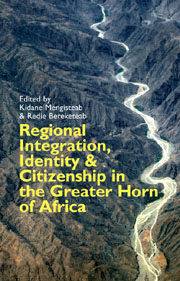Book contents
- Frontmatter
- Contents
- List of Tables, Figures & Appendices
- Notes on Contributors
- Acknowledgements
- List of Acronyms
- Part One RELEVANCE OF INTEGRATION TO IDENTITY AND CITIZENSHIP
- 1 Relevance of Regional Integration in the Greater Horn Region
- 2 Re-conceptualizing Identity, Citizenship and Regional Integration in the Greater Horn Region
- 3 A Diversity Perspective on Identity, Citizenship and Regional Integration in the Greater Horn of Africa
- Part Two CRITICAL FACTORS IN INTEGRATION
- Part Three LESSONS FROM SELECTED AFRICAN INTEGRATION SCHEMES
- Index
- EASTERN AFRICAN STUDIES
1 - Relevance of Regional Integration in the Greater Horn Region
from Part One - RELEVANCE OF INTEGRATION TO IDENTITY AND CITIZENSHIP
Published online by Cambridge University Press: 05 February 2013
- Frontmatter
- Contents
- List of Tables, Figures & Appendices
- Notes on Contributors
- Acknowledgements
- List of Acronyms
- Part One RELEVANCE OF INTEGRATION TO IDENTITY AND CITIZENSHIP
- 1 Relevance of Regional Integration in the Greater Horn Region
- 2 Re-conceptualizing Identity, Citizenship and Regional Integration in the Greater Horn Region
- 3 A Diversity Perspective on Identity, Citizenship and Regional Integration in the Greater Horn of Africa
- Part Two CRITICAL FACTORS IN INTEGRATION
- Part Three LESSONS FROM SELECTED AFRICAN INTEGRATION SCHEMES
- Index
- EASTERN AFRICAN STUDIES
Summary
INTRODUCTION
The Greater Horn of Africa Region (GHR) can be said to comprise eleven countries – Burundi, Djibouti, Eritrea, Ethiopia, Kenya, Rwanda, Somalia, South Sudan, Sudan, Tanzania and Uganda. However, for the purposes of the discussions in this book, Burundi, Rwanda and Tanzania are often omitted.
The GHR is a region engulfed by three interrelated crises. One crisis comprises the various types of devastating conflicts, including inter-state wars, civil wars and inter-communal conflicts. The second is an economic crisis manifested in widespread debilitating poverty, chronic food insecurity and frequent cycles of famine. The third crisis is the alarming rate of environmental degradation that is ravaging the region. This environmental crisis is manifested by cyclical droughts, rising temperatures, deforestation, loss of vegetation and biodiversity, increased soil erosion, desiccation and desertification. The three types of crises are mutually reinforcing. The conflicts, in disrupting the production system, contribute to poverty. Deepening poverty, in turn, along with global climatic changes and rapid population growth, intensifies environmental degradation and the scarcity of vital resources, such as land and water. Such scarcities, of course, fuel more conflicts.
The combined effects of the three-pronged crisis have turned the Greater Horn of Africa Region (GHR) into a zone of humanitarian crisis and a major source of refugees in the global system. The region's refugees in 2008 were estimated at 1,248,565 while the figure of the internally displaced was estimated at about 8.5 million (World Bank, 2008; UNDP, 2007/8).
- Type
- Chapter
- Information
- Publisher: Boydell & BrewerPrint publication year: 2012

